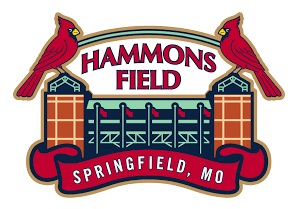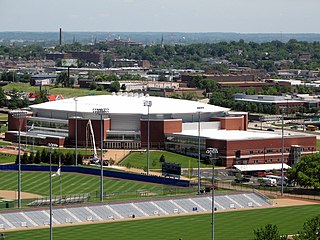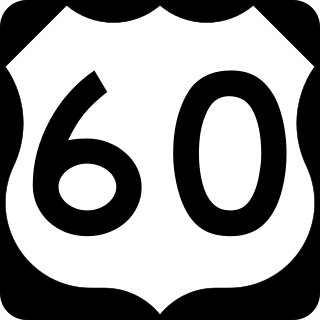
Hammons Field is a minor league baseball stadium located in Springfield, Missouri, with a capacity of 7,986 plus approximately 2,500 general admission seating. The facility, funded entirely by local businessman, hotel mogul and benefactor John Q. Hammons, is the centerpiece of the midtown development project, Jordan Valley Park, on the corner of Sherman Avenue and Trafficway Boulevard. Completed in April 2004, it is home to the Springfield Cardinals, the Texas League affiliate of the St. Louis Cardinals as well as the Missouri State University Bears.

Dell Diamond is the home stadium of the Round Rock Express, the Triple-A Minor League Baseball affiliate of the Texas Rangers major league baseball team. On April 16, 2000, the then-Double-A affiliate Express played their first home game at the stadium.
The Trinity Health Arena is a 3,000-seat multi-purpose arena in Muskegon, Michigan, United States. It was built in 1960 in partnership with philanthropist and industrialist Louis Carlisle Walker at a cost of $2 million, and on October 27, 1960, was formally gifted to the City of Muskegon. Mr. Walker provided $1 million and the City provided $1 million toward the cost. It is currently home to the Muskegon Lumberjacks of the United States Hockey League, Muskegon Risers SC of Major Arena Soccer League 2, and the West Michigan Ironmen indoor football team. The Arena will change its name to Trinity Health Arena after a corporate decision to rename Mercy Health facilities Trinity Health.

Roger Dean Stadium is a baseball stadium located in the Abacoa community of the town of Jupiter, Florida. The stadium was built in 1998, holds 6,871 people, and features luxury sky-box seating, two levels of permanent seating, parking and concessions. The Roger Dean Stadium Complex is the only stadium in the country to host four minor league teams: the Jupiter Hammerheads and Palm Beach Cardinals of the Florida State League, and the Florida Complex League Marlins and Florida Complex League Cardinals of the Rookie-level Florida Complex League.

121 Financial Ballpark is a baseball park in Jacksonville, Florida. It is the home stadium of the Jacksonville Jumbo Shrimp Minor League Baseball team, who play in the International League. The facility opened in 2003.

Momentum Bank Ballpark is a ballpark in Midland, Texas. It is primarily used for baseball, and is the home field of the Double-A Midland RockHounds minor league baseball team of the Texas League. Opened in 2002, the stadium holds 6,669 people with 4,709 fixed seats and the rest in berm seating.

Lake Elsinore Diamond, also referred to as Storm Stadium, is a baseball park in Lake Elsinore, California. It is primarily used for baseball and is the home field of the Lake Elsinore Storm minor league baseball team in the California League. The field at Diamond Stadium is named Pete Lehr Field.

William L. Grayson Stadium is a stadium in Savannah, Georgia. It is primarily used for baseball, and is the home field of the Savannah Bananas, an exhibition baseball team. It was the part-time home of the Savannah State University college baseball team from 2009 to 2011. It was also used from 1927 until 1959 for the annual Thanksgiving Day game between Savannah High School and Benedictine Military School. Known as "Historic Grayson Stadium", it was built in 1926. It holds 4,000 people. It also served as the home of the Savannah Sand Gnats from 1984 to 2015.
Greenlee Field in Pittsburgh, Pennsylvania, was one of only a few Black-built and Black-owned major league baseball fields in the United States. The field was the dream of Gus Greenlee, owner of the Pittsburgh Crawfords.

Chaifetz Arena, is a 10,600 seat multi-purpose arena in St. Louis, Missouri located on the Saint Louis University campus. The arena began construction on August 28, 2006 and opened on April 10, 2008.

The Hollywood Casino Amphitheatre is an outdoor concert venue in Maryland Heights, Missouri, near St. Louis.

The Stifel Theatre is a civic performing arts building located in St. Louis, Missouri.
William Baumgarten & Co. was an interior design firm and the first American producer of Aubusson-style tapestries. The manufactory was active between 1893 and 1914.

Springbok (1870–1897) was an American Thoroughbred racehorse who won the seventh Belmont Stakes in 1873. Foaled in 1870, he was sired by the imported stallion Australian, his dam was a daughter of Lexington. During his racing career he started 25 races, winning 17 of them. Besides the Belmont, Springbok won the Saratoga Cup twice, in 1874 and 1875 and was named Champion Older Male horse in 1874 and 1875. After retiring from the racetrack, he sired five stakes winners and died in 1897.

Ellis Wainwright was an American capitalist, brewer, art collector and socialite from St. Louis, Missouri. He was President of the St. Louis Brewing Company and Director of the St. Louis and Suburban Company. He is best known for the Wainwright Building in downtown St. Louis, which was one of the first skyscrapers in the world and one of the most important office buildings of the period.

The Stevens Building is a commercial and office building located in downtown Portland, Oregon, listed on the National Register of Historic Places. The 12-story building was designed by Whidden & Lewis. The design is similar to the Failing Office Building (1907) and Wilcox Building (1911), also by Whidden & Lewis. Construction began in August 1913 and was completed in 1914, with the building opening on May 1, 1914. The total construction cost was $375,000. The building is approximately 152 feet (46 m) tall.

U.S. Route 60 and U.S. Route 62 (US 60/US 62) run for a very short distance within the state of Illinois. The highways run concurrently for their entire existence within the state. The joint highway runs around Fort Defiance in Cairo, from the Cairo Mississippi River Bridge over the Mississippi River east to the Cairo Ohio River Bridge over the Ohio River; the Ohio River Bridge also carries US 51. The bridges cross the two rivers just north of the mouth of the Ohio.
William David Orthwein was a German-born American Civil War veteran and grain merchant in St. Louis, Missouri.

Old Warson Country Club is a country club located in St. Louis, Missouri. Founded in 1953, it hosted the 1971 Ryder Cup and the 2009 U.S. Women's Amateur Golf Championship. The golf course was designed by Robert Trent Jones.

Luigi V. Fugazzi, nicknamed Papa Fugazy, was an Italian American banker, businessman, and philanthropist who became one of the most prominent padroni in the United States. He emigrated to the United States in 1869 and established a bank and a service company for Italians in New York City's South Village. He also established and supported many Italian mutual aid societies and fraternal organizations in the city.



















